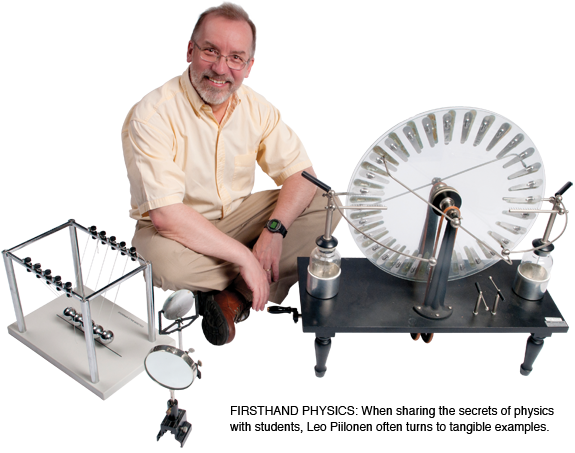PROFESSOR PROFILE

In physics, many of the concepts can be formidable for students to grasp.
In Leo Piilonen's classroom, however, the subject matter tends to leap off the pages of the textbooks—more literally than you might imagine.
Piilonen brings challenging material to life with Flash animations of his own creation—one approach to interactive learning employed by the university's 2011 William E. Wine Award winner.
"Just seeing the images in static form in the pages of a textbook doesn't even begin to convey all of the interesting and fun dynamics within the material," said Piilonen, who was recently appointed the chair of the Department of Physics and the William E. Hassinger Jr. Senior Faculty Fellow in Physics. "[Students are] not just watching an animation; they're able to tweak and change it to see what happens as a result of the change they made."
Changing the nature of physics education itself—through his superb teaching, an advocacy of instructional technology, and effective leadership of curriculum-related governance—earned Piilonen the Wine award.
According to his teaching assistant, Chris Martin, Piilonen's flexible teaching style engenders a broader scope of understanding. "All too often, professors stand in front of a crowded classroom and lecture in front of a chalkboard or PowerPoint, leaving the students to take notes and attempt to stay awake," said Martin. "By using a multifaceted lecture approach, Piilonen reaches out to more students with various learning styles."
An early adopter of instructional technology, Piilonen often uses iClickers, handheld devices that allow him to collect and react to immediate student feedback. The practice also leads to peer instruction, allowing students to discuss complicated topics in a language they understand: their own.
"If they're hearing it from me, there's a distance between the student and the professor that, for better or worse, I can't remove," said Piilonen. "If they hear the same information from a classmate, that distance dissolves, and the students are much more easily able to connect wholly with the material."
In a related fashion, Piilonen initiates discussion and then lets the students make their own mistakes. "Instead of telling students how to complete a problem, I say, ‘Think about this,'" he said. "[The process lets] them go a little way into the wrong approach, lets them fall onto the wrong trail, and they'll figure out they made a mistake just by going through the process of explaining why they took that route. Just by explaining it, they'll realize where they made a wrong turn."
Piilonen is interested not so much in hearing students repeat the "right" answers but in seeing that the students comprehend the underlying concepts—which is why he remains flexible.
"To some extent [that comprehension is] a challenge for me as well as the students," he said. "You have to learn what is the most effective way to connect with one's students, and that effective way truly varies from course to course depending on its level of difficulty. I'm constantly finding new ways to communicate with my students, and I find that very refreshing."
"[Piilonen] is always asking for our input and tweaking his teaching style in response," said Julia Zukowski, who recently completed Piilonen's Foundations of Physics I course as a freshman. "My table was asked to chat with him about the value of homework and in-class activities during recitation, and he took notes on our responses."
In his 25 years at Virginia Tech, Piilonen has constantly integrated new technology. As the physics department's first webmaster, he helped the department develop one of the university's first websites. He was quick to realize the potential of Scholar, an online learning-management system, posting Flash animations and in-class videos for students to view at their own convenience.
Physics instructor Alma Robinson admires Piilonen's determination and adaptability. "[He] has a reputation among his students [as] someone who is extremely patient and helpful both in his classroom and during office hours, a key reason he has had so much success as a teacher," she said. "He constantly pushes himself to be a better teacher."
Piilonen's influence at Virginia Tech is sizeable. During his tenure as chair of the physics department's undergraduate committee, he managed the development of the Physics ViEWS policy, designed to emphasize communication and a broader scope of learning. Demonstrating research excellence, Piilonen investigated the behavior of matter versus antimatter as one of the founding members of the Belle experiment, an internationally known research program in high-energy particle physics that measured and conclusively validated the predictions of physicists who earned the 2008 Nobel Prize in physics.
"Beyond the superficial exposure of including examples of our own research to illustrate concepts in our teachings, we try to encourage every student to work with faculty during the semester or summer on a project," said Piilonen. "[The collaboration] gives them a chance to get their hands dirty, puts their ideas into practice, and gives them a chance to have their research published."
As technology continues to evolve, so do Piilonen's teaching methods. By the fall semester, he hopes to begin utilizing the touch-sensitive technology of smartphones and tablets. "With animations, there isn't any touch feedback," he explained. "If you could make alterations using hand gestures or a swipe of the finger, it would be fantastic. It would be great to get that extra connection to the student and to give them the ability to manipulate animations and see how they evolve over time."
Martin praised Piilonen's willingness to take risks in order to teach students. "This open approach, with the understanding that no single instructional technique is perfect, shows his compassion and continuous efforts to ensure the success of his students," he said.